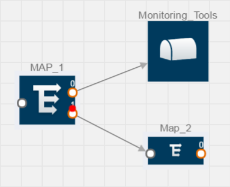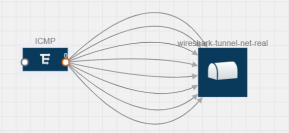Overview of Visibility Components
The GigaVUE V Series node aggregates the traffic from G-vTAP containers and filters them using maps. It applies intelligence and optimization to the aggregated traffic using GigaSMART applications such as Flow Mapping®™, sampling, slicing, and masking, and distributes them to the tunnel endpoints.
Table 1: Components of Traffic Visibility Sessions lists the components of the monitoring session:
|
Parameter |
Description |
||||||
|
Map |
A map (M) is used to filter the traffic flowing through the V Series node. It is a collection of one or more rules (R). The traffic passing through a map can match one or more rules defined in the map. |
||||||
|
Rule |
A rule (R) contains specific filtering criteria that the packets must match. The filtering criteria lets you determine the targets and the (egress or ingress) direction of tapping the network traffic. A rule is also associated with priority and action set. |
||||||
|
Priority |
A priority determines the order in which the rules are executed. The greater the value, the higher the priority. The priority value can range from 0 to 99. |
||||||
|
Action Set |
An Action Set is an exit point in a map that you can drag and create links to the other maps, applications, and monitoring tools. A single map can have multiple action sets. A single action set can have multiple links connecting to maps and applications. You can create an Action Set when you create a rule for a map. In the following example (refer to Figure 1: Action Set), Map 1 has two action sets: Action Set 0 and Action Set 1. The packets that match the rules in Action Set 0 are forwarded to monitoring tools. The packets that match the rules in Action Set 1 are forwarded to Map 2.
A single action set can have up to 8 links connecting the same destination point. The same packets from the map are replicated in 8 different links.
|
||||||
|
Link |
A link directs the packets to flow from a map to the destination. The destination could be the other maps, applications, and the monitoring tools. In Figure 1: Action Set, the link originating from action set 0 is moving the traffic from MAP_1 to Monitoring_Tools. A link lets you add header transformation to the packets passing through it before they are sent to the destination. This transformation is supported only with GigaVUE V Series node v1.2-1 and above. For more information about Header Transformation, refer to Add Header Transformations. |
||||||
|
Group |
A group is a collection of maps that are pre-defined and saved in the map library for reuse. |
||||||
|
Application |
An application performs operations such as sampling, slicing, and masking on the traffic. |
||||||
|
Inclusion Map |
An inclusion map determines the instances to be included for monitoring. This map is used only for target selection. |
||||||
|
Exclusion Map |
An exclusion map determines the instances to be excluded from monitoring. This map is used only for target selection. |
||||||
|
Target |
A target determines the instances that are to be monitored. Targets are determined based on the following formula: |
||||||
|
Automatic Target Selection (ATS) |
A built-in feature that automatically selects the cloud instances based on the rules defined in the maps, inclusion maps, and exclusion maps in the monitoring session. |
||||||
|
Tunnel |
A tunnel lists the monitoring tools to which the traffic matching the filtered criteria is routed. |





